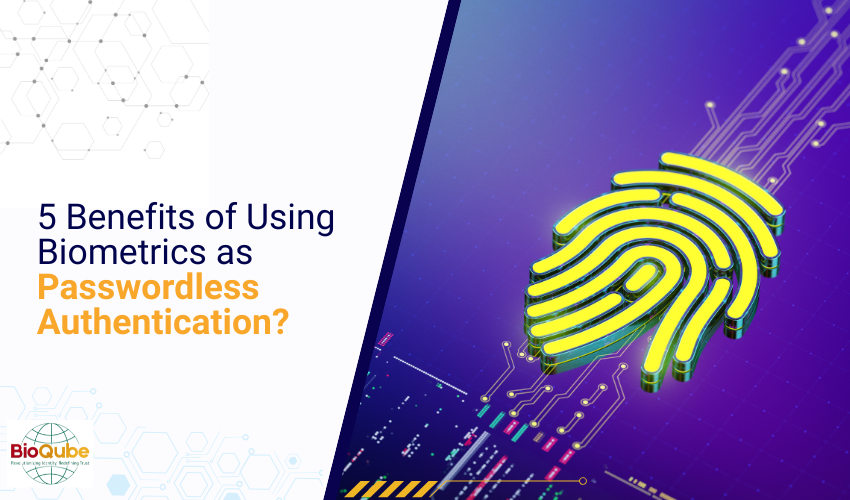
Biometrics are one of the most widely used methods of passwordless authentication as they offer enhanced security and convenience. They make accounts and access highly reliable, which isn’t the same for One-Time Passwords (OTPs) and PINs.
Moreover, when a user engages with more than one method of biometric authentication as part of the multifactor security protocol incorporated in most global organizations, it makes the system nearly impenetrable.
Biometric systems encompass an individual’s physiological or behavioral traits, which are unique in characteristics and require highly sophisticated mechanisms to replicate, especially if they are contactless.
5 Reasons to Opt for Biometrics as Passwordless Authentication
Biometrics come with a host of advantages that make them the most suitable passwordless authentication, such as:
High Assurance of the End User
Unlike OTPs and PINs which can get hacked and reused for accessing accounts or access, biometrics are highly reliable. They require the end user’s presence in front of a registered device.
Stakeholders across industries like BFSI, gaming, healthcare, etc., have realized the importance of using biometrics instead of the alternatives. For example, biometrics can simplify account opening and app access.
They can verify the physical characteristics registered on the account with the photo uploaded on a government identity proof. Under the health domain, this can help to avoid insurance fraud claims and provide benefits to the right policyholder.
Diminishes the Administrative Overhead
The IT department is constantly burdened with password reset tickets. The larger the organization the more chances of a high number of reset requests. As a result, a core amount of time is spent on resolving them, the worker’s productivity is hampered until it is accepted, and the organization’s productivity is hampered.
According to multiple pieces of research, organizations bear a cost of $70 per password reset. Hence, the loss goes in thousands to millions of dollars depending on the total raised requests. Therefore, passwords have become redundant methods of authentication and require replacement.
Biometrics eliminates the need for raising password reset requests as they identify the end user through the biometrics. If the organization engages with face recognition technology integrated with liveness detection the chance of end-user assurance is heightened and overhead costs plummet.
Higher Convenience to the User
Another key advantage of using biometric technology like face recognition as passwordless authentication is that it removes the friction generally associated with security systems requiring PINs or OTPs.
They provide seamless verification without human intervention and simplify the entire process. Traditionally, systems with multifactor authentication required the end user to add a password and then enter a PIN or OTP sent to their device.
The hassle of remembering multiple PINs and passwords led to the malpractice of using the same ones everywhere. As a result, accounts became vulnerable, and sensitive documents could get hacked easily. Nowadays, biometrics have resolved this by recognizing the unique biological characteristics.
For example, fingerprint or face recognition systems don’t require remembering anything and cannot get penetrated easily if the system is secured with encryption, liveness detection, and other features too.
Low Risk of Identity Theft or Fraud
Organizations that choose to opt for multifactor biometric authentication have a lower risk of becoming victims of identity theft or fraud as they are unique to individuals. For the same reason, they make systems highly secure and minimize the risk of tampering or spoofing.
Biometric identities are often linked with documents during the electronic Know Your Customer (e-KYC) process, which is part of the user onboarding or account opening. However, organizations also link the user’s identity with cards and provide access. By using face recognition all of this process gets streamlined and reduces the risk of identity theft or fraud.
Assures User’s Geolocation Presence
Passwords, PINs, and OTPs can be told and used by someone else to receive access, authenticate, mark attendance, etc. It is common practice in organizations to use shared online accounts. However, if the second user accesses the account without permission, the trouble could befall on the registered user and cause major organizational problems.
Face recognition integrated with liveness detection, geolocation, and geofencing can ensure the presence of the registered user at the designated location. It cultivates trust and transparency in the system, which is often problematic with other authentication methods.
While the geolocation feature captures the accurate latitude and longitude, geofencing helps to avoid taking the associated action beyond a radius. If enterprises install a centralized device, the users must be present in front of it. On the other hand, if biometric tampering or spoofing attempts happen via a new device the registered user and admins receive an alert while avoiding penetration into the system.
Conclusion
Biometrics as a passwordless authentication system offers more advantages than other methods. They provide enhanced security, lower the risk of identity theft and fraud, assure the presence of the end user at the designated location, and increase user convenience.
Moreover, they diminish the administrative overhead tickets often raised when a user forgets passwords or PINs or doesn’t have the designated device to receive the OTP. Since biometrics capture the physiological characteristics of the individual, it establishes trust and transparency in the organization.
Contactless biometric technology, such as voice and face recognition streamlines the process of managing attendance, access, or authentication, eliminating the risk of human error. Schedule a demo with us to learn more about the advantages of Bioqube’s biometric technology for your organization.